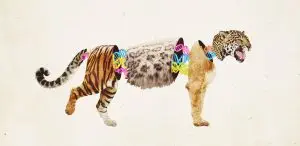 Hybrids, once treated as biological misfits, have been the secret saviors of many animal species in trouble. Reconciling that truth with conservation policies poses a challenge for science.
Hybrids, once treated as biological misfits, have been the secret saviors of many animal species in trouble. Reconciling that truth with conservation policies poses a challenge for science.
The five big cats of the Panthera genus — leopards, tigers, snow leopards, lions and jaguars (as represented from left to right in the figure) — interbred repeatedly during the millions of years since their species diverged. Such hybridizations turn out to be surprisingly common and important in animal species evolution.
Understanding species-in-environment as a key unit of survival is hard enough to grasp – but understanding the gene-pool-environment mutualism as the foundation of dynamic ecology-niche-instantiations is even harder. From horizontal-gene-transfer to endogenesis evolution is emerging as ever more complex. This is another fascinating article signalling the change in biological and evolutionary paradigms.
In 2006, a hunter shot what he thought was a polar bear in the Northwest Territories of Canada. Closer examination, however, revealed brown patches on its white fur, uncharacteristically long claws and a slightly hunched back. The creature was in fact a hybrid, its mother a polar bear, its father a grizzly. Although this cross was known to be possible — the two species had mated in captivity before — this was the first documented case found in the wild. Since then, it has become clear that this was not an isolated incident. Conservationists and others worry that if climate change continues to drive grizzly bears into polar bear territory, such interbreeding will become more common and will devastate the polar bear population. Some have even proposed killing the hybrids in an effort to conserve the species.
But grizzlies and polar bears, as it turns out, have been mating since the species diverged hundreds of thousands of years ago. Polar bear genomes have retained mitochondrial DNA from ancient grizzly bears, and grizzlies have inherited genes from hybridizing with polar bears. “People worry that if they interbreed, polar bears will lose their beautiful white coats,” said Michael Arnold, an evolutionary biologist at the University of Georgia. “But the truth is these organisms have not been looking entirely like themselves for a long time now.”
“If this mixing is a common natural event,” he warned, “then killing hybrids to prevent them from mixing with the ‘pure’ parent genomes is not a management technique we should do lightly.” In fact, it may be that the genetic variation introduced by this kind of hybridization could save the polar bears, whose survival in the face of rising temperatures and melting ice may hinge on their ability to adapt to a rockier, less frozen habitat. Taking in some genes from grizzly bears is highly likely to be adaptive for polar bears, Arnold said, even though the results “won’t look exactly like a polar bear.”
…And the process doesn’t end with speeding up evolution in a single species. Adaptive introgression can in turn contribute significantly to adaptive radiation, a process by which one species rapidly diversifies into a large variety of types, which then form new lineages that continue to adapt independently. The textbook case can be found in the great lakes of East Africa, which are home to hundreds upon hundreds of cichlid species, a type of fish that diversified in explosive bursts (on the evolutionary timescale) from common ancestors, largely in response to climatic and tectonic shifts in their environment. Today, cichlids vary widely in form, behavior and ecology — thanks in large part to introgressive hybridization…..
Leave a Reply